Immutable Data Structures
I already discussed that all data structures in purely functional programs are immutable; see Lecture 1. In this lecture, I will introduce some examples of immutable data structures that can be used as alternatives to common mutable data structures from imperative programming languages. It is beyond this introductory course to study immutable data structures in detail. I hope these examples will give you a brief insight into the topic.
From the general perspective, we distinguish two kinds of data structures:
- Immutable (aka persistent) data structures cannot be changed during their existence. Their advantage is that they can be safely shared between several data structures or concurrent threads. On the other hand, immutable data structures often have worse complexity bounds than their mutable equivalents. For example, we can look up an element stored in a mutable array at a given index in constant time
. The same operation over an immutable array usually works in logarithmic time with respect to the array size . - Mutable (aka ephemeral) data structures can be modified, but their previous versions are lost. They have better complexity bounds. On the other hand, they cannot be safely shared as the shared part might be mutated.
To illustrate the issues with sharing mutable data, consider the following code in Racket:
(define x '(0 1 2 3 4))
(define y (cdr x))We defined a list x consisting of five elements. As Racket lists are immutable, we can safely share their content. Thus the defined list y shares all its members with x.
On the other hand, consider the same situation in Python:
x = [0,1,2,3,4]
y = x[1:]As Python lists are mutable, y cannot share its content with x because x might be later modified. For example, y[0] equals 1 even after modifying x as follows:
x[1] = 333Consequently, to create y, we must copy all the elemets from x[1:].
Lists
Before I describe some clever immutable data structures, I will focus on how immutability affects lists which are fundamental data structures for Racket. Recall that lists are built out of pairs whose first component carries data and the second component contains the continuation of the list. Internally, the second component is a pointer to the next pair. In other words, lists are stored as singly linked lists. Consequently, we can easily extract the first element and add a new element at the beginning of the list. More precisely, we can do it in constant time
Let us see in more detail what happens if we concatenate two lists. Appending a list ys to a list xs, requires linear time in the length of xs. The append function can be implemented in Racket as follows:
(define (my-append xs ys)
(if (null? xs)
ys
(cons (car xs) (my-append (cdr xs) ys))))If xs is empty, there is nothing to do. The result is ys. Otherwise, we append recursively ys to (cdr xs) and prepend (car xs) to the result of the recursive call. The function my-append above is not tail recursive. I chose this version because it is conceptually simple and better for further explanation. If you wonder how to implement append as a tail-recursive function, you can check it below:
(define (my-append-tailrec xs ys)
(define (iter l acc)
(if (null? l)
acc
(iter (cdr l) (cons (car l) acc))))
(iter (reverse xs) ys))Now return to the first implementation of my-append. To practice pattern matching, let me reimplement it via match:
(define (my-append xs ys)
(match xs
[(list) ys]
[(list x us ...) (cons x (my-append us ys))]))Suppose we append a list ys to a list xs and name the resulting list zs:
(define zs (my-append xs ys))What happens is that xs is recursively decomposed and copied so that its copied version is connected to ys. The situation is depicted below on three-element lists '(1 2 3) and '(4 5 6).

Both original lists xs and ys are persistent, i.e., none is destroyed. Moreover, ys shares its members with the resulting list zs. This contrasts with the imperative setting where appending might be destructive. Updating the second component of the last pair in xs so that it points to ys, destroys the original xs as we do not know where it ends.
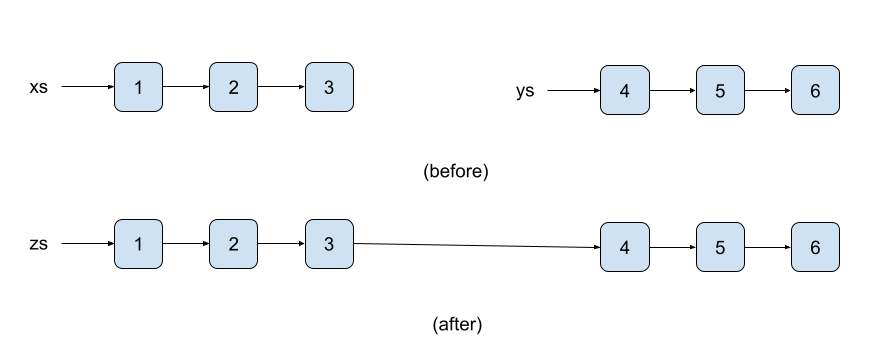
An analogous situation occurs if we need to modify an element at a given position in a list. It requires linear time
(define (my-list-set lst pos val)
(match (cons lst pos)
[(cons (list) _) (error "Incorrect index")]
[(cons (list _ xs ...) 0) (cons val xs)]
[(cons (list x xs ...) i) (cons x (my-list-set xs (- i 1) val))]))
(my-list-set (range 10) 4 'a) => '(0 1 2 3 a 5 6 7 8 9)Note in the above code that we need to match against the given list and position. Thus we make a pair from the list and position and match the pair (Line 2). Modifying the empty list leads to an error (Line 3). If the xs (Line 4). Otherwise, x is copied and consed to the result of the recursive call (Line 5).
Queues
Queues are common data structures representing a buffer. It stores data in the order they are coming in and releases the first-coming elements first. A queue is usually endowed with two operations: enqueue and dequeue. The first adds new-coming data to the back of the queue. The second removes the data stored in the front.

Following the tradition of functional programming, I will call enqueue and dequeue, respectively, snoc and tail. snoc is cons spelled backward, so its name should express that it adds an element to the back of the queue. Apart from snoc and tail, I also implement the function head reading the first element of the queue.
The question is how to implement queues in a purely functional language. A naive solution would use just lists as follows:
(define naive-head car)
(define naive-tail cdr)
(define (naive-snoc x q) (append q (list x)))Note that naive-snoc applies the function append, which requires time snoc in the purely functional setting if we cannot modify the pair holding the last element of the queue? The idea is simple. We will represent a queue via two lists: the front list and the rear list.
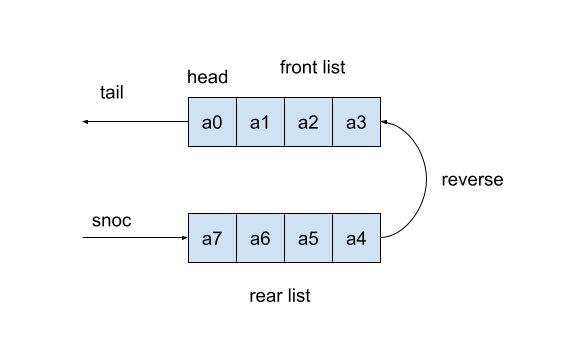
We strip off the first element from the front list to dequeue an element. It can be done in constant time
The implementation of the improved queue in Racket is below:
(struct queue (front rear) #:transparent)
(define empty-queue (queue '() '()))
(define (queue-empty? q) (null? (queue-front q)))
(define (check q)
(if (null? (queue-front q))
(queue (reverse (queue-rear q)) '())
q))
(define head (compose car queue-front))
(define (snoc x q)
(check (queue (queue-front q) (cons x (queue-rear q)))))
(define (tail q)
(check (queue (cdr (queue-front q)) (queue-rear q))))We represent the queue as a structure with two components: the front and rear list (Line 1). The empty queue consists of two empty lists (Line 3). The implementation maintains the invariant that the queue is empty if, and only if, the front is empty. Thus to test if the queue is empty, we check if the front list is empty (Line 5). The function check (Line 7) maintains the invariant. If the front list is empty (Line 8), we create a new queue whose front list is the reverse of the rear list, and the rear is empty (Line 9). If the front list is non-empty, we return the input queue q (Line 10).
Now the main functions. head simply extracts the first element of the front list (Line 12). snoc creates a new queue whose front list is preserved, and the rear list is expanded by the new element x (Line 15). Moreover, we must check if the invariant holds. In fact, the only case when the invariant might be invalid is when we snoc a new element into the empty queue. Similarly, tail removes the first element of the front list and checks the invariant (Line 18).
Let us see how the improved queue works. If we enqueue a symbol 'a to the empty queue, it inserts 'a into the rear list. As the front list is empty, the function check reverses the rear list and makes it the front list.
(snoc 'a empty-queue) => (queue '(a) '())If we continue adding new elements into the queue, they are consed to the rear list.
(snoc 'c (snoc 'b (snoc 'a empty-queue))) => (queue '(a) '(c b))Once we dequeue the first element, the front list becomes empty again, so check must fix the invariant by reversing the rear list.
(tail (snoc 'c (snoc 'b (snoc 'a empty-queue)))) => (queue '(b c) '())If we add further elements, they are consed to the rear list.
(snoc 'd (tail (snoc 'c (snoc 'b (snoc 'a empty-queue))))) => (queue '(b c) '(d))Now we can compare the performance of the naive queue and the improved one. To test the performance, we generate a list of random queue commands consisting either of the symbol 'tail or a symbol to be enqueued.
(define (make-data n)
(define rnd-lst (map random (make-list n 2)))
(define (generate-event k)
(match k
[1 (gensym)]
[0 'tail]))
(map generate-event rnd-lst))Line 2 generates a random sequence of zeros and ones. The function generate-event (Lines 3-6) converts zeros to 'tail and ones to fresh symbols (they can be generated by gensym). Finally, Line 7 creates testing data. The output of make-data might look as follows:
(make-data 10) =>
'(g6642396 g6642397 g6642398 tail tail g6642399 g6642400 g6642401 g6642402 tail)Next, we need a function applying the testing data to a particular queue.
(define (test-data q0 empty? enq deq data)
(define (exec cmd q)
(match cmd
['tail (if (empty? q) q (deq q))]
[el (enq el q)]))
(foldl exec q0 data))The function test-data accepts an initial queue q0, a predicate testing queue's emptiness empty?, functions enq and deq enqueuing and dequeuing an element, and testing data. The local function exec (Lines 2-5) executes a command cmd on the queue. If cmd is 'tail, the first element is dequeued provided the queue is non-empty. Otherwise, cmd is an element to be enqueued. Line 6 runs all the commands on the initial queue q0.
Now it remains to measure the times needed to evaluate test-data. We first create testing data data and then compare the performance. To prevent displaying the large queues on the screen, we can enclose the call of test-data inside begin and returns just a value 'done.
(define data (make-data 1000000))
(time (begin (test-data empty-queue queue-empty? snoc tail data) 'done))
(time (begin (test-data '() null? naive-snoc naive-tail data) 'done))
cpu time: 62 real time: 64 gc time: 31
'done
cpu time: 1718 real time: 1769 gc time: 218
'doneThe first time corresponding to the improved queue is considerably shorter than the second one corresponding to the naive implementation.
Random access lists
Arrays are the most common data structures in imperative programming. An array is a collection of indexed elements that can be quickly accessed and updated, i.e., in constant time
Analogously to queues, one can naively implement arrays as lists. However, as we already know, the lookup and update operations run in linear time
The problem with the regular list is that their length equals their size. Thus, it takes a linear time if we want to iterate through them to look up an element. To overcome this, we can split the list's members into chunks so that there are only logarithmically many chunks. The way we create the chunks is based on the binary numeral system. Recall that every number
Suppose we want to represent an array of size
As the chunks are of size
Altogether, we represent an array of size
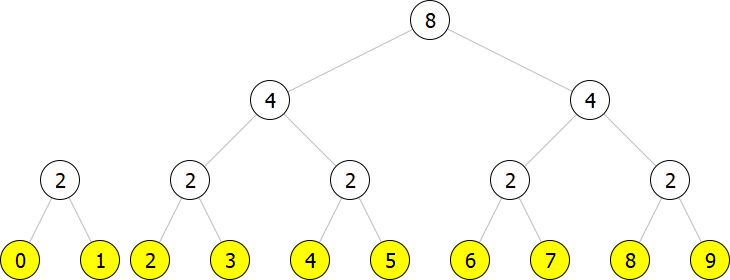
The chunks corresponding to non-zero bits are the binary trees. Their leaves (yellow nodes) hold the data. For convenience, the inner nodes (white nodes) contain information about the number of leaves below them.
Now we can discuss how to implement this representation in Racket. We define two structures—one for the inner nodes and the other for the leaves.
(struct node (size left right) #:transparent)
(struct leaf (val) #:transparent)Thus the inner node is a triple consisting of the number of leaves below it and left and right subtrees. The leaf contains only a value. So the above-depicted list of trees is represented in Racket as follows:
(list (node 2 (leaf 0)
(leaf 1))
(node 8 (node 4 (node 2 (leaf 2)
(leaf 3))
(node 2 (leaf 4)
(leaf 5)))
(node 4 (node 2 (leaf 6)
(leaf 7))
(node 2 (leaf 8)
(leaf 9)))))Next, we need to deal with a function building random access lists. In particular, we will implement a function cons-el, adding one new element to an existing random access list. Adding a new element to a random access list of size
Let us see how the binary increment by
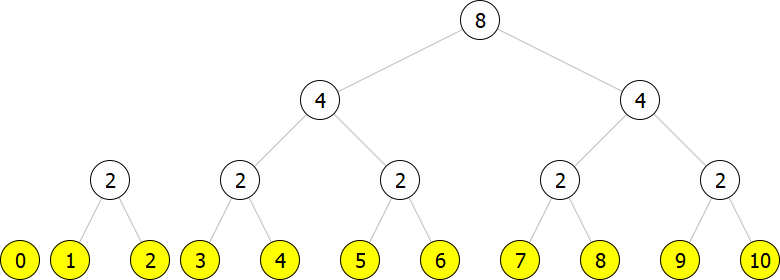
Now we add a new element, say (leaf -1).
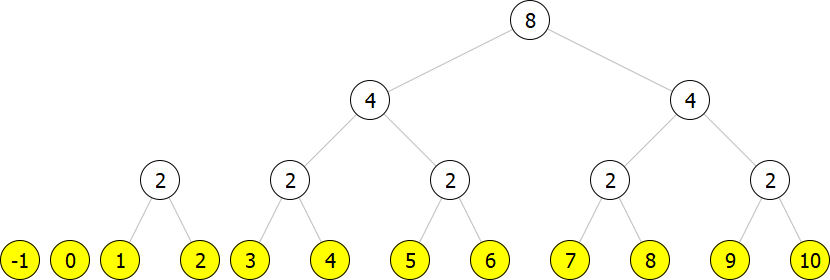
However, this is not a correct representation because we have two trees of size

The result is still not a correct representation as we have two trees of size

Now we have a correct representation for the array of size
To compare the sizes of trees, we need a helper function returning the size of a tree/chunk, i.e., the number of leaves in a tree.
(define (size t)
(match t
[(node w _ _) w]
[(leaf _) 1]))The function size matches the root node of the input tree. If it is a leaf, then the size is
Further, it is necessary to implement a function joining two trees of sizes
(define (link t1 t2)
(node (+ (size t1) (size t2)) t1 t2))The function link joins two trees and adds a new root node with the sum of their sizes.
The following function cons-el inserts an element into a random access list lst.
(define (cons-el el lst)
(cons-tree (leaf el) lst))
(define (cons-tree t lst)
(match lst
[(list) (list t)]
[(list t2 ts ...)
(if (< (size t) (size t2))
(cons t lst)
(cons-tree (link t t2) ts))]))The element is added to lst as a tree (leaf el) of size cons-tree (Line 2). The helper function inserts a tree t into lst. It matches lst and, based on its structure, decides how to insert t. If lst is empty (Line 6), we return a singleton list containing only t. If lst is non-empty (Line 7), we extract its first tree t2. We must compare the sizes of t and t2 (Line 8). When t is strictly smaller than t2, we simply cons t to lst (Line 9). We can do that because no tree in lst has the same size as t. Otherwise, the sizes must be equal. Thus we must join the trees and recursively insert the joined tree (Line 10).
Let us see the first few calls of cons-el if we build a random access list from the empty one.
(cons-el 'a '()) => (list (leaf 'a))
(cons-el 'b (cons-el 'a '())) => (list (node 2 (leaf 'b)
(leaf 'a)))
(cons-el 'c (cons-el 'b (cons-el 'a '()))) => (list (leaf 'c)
(node 2 (leaf 'b)
(leaf 'a)))
(cons-el 'd (cons-el 'c (cons-el 'b (cons-el 'a '())))) =>
(list (node 4 (node 2 (leaf 'd)
(leaf 'c))
(node 2 (leaf 'b)
(leaf 'a))))Inserting the first element 'a creates a list containing only (leaf 'a) (Line 1). Adding the second element 'b must join two leaves; thus we end up with a single binary tree of size 'c is included as (leaf 'c) (Lines 6-8). Finally, inserting the forth element 'd' results in a single tree of size
One can also implement a function tail removing the first element from a given random access list lst. It extracts the first tree/chunk t from lst and removes its first element by the function tail-tree. If t is a leaf, we just discard it. Otherwise, we split the tree into the left and right subtrees. The right subtree is preserved, and we recursively remove the first element from the left subtree.
(define (tail lst)
(match lst
[(list) (error "empty list")]
[(list t ts ...) (tail-tree t ts)]))
(define (tail-tree t ts)
(match t
[(leaf _) ts]
[(node _ t1 t2) (tail-tree t1 (cons t2 ts))]))Now, we know how to build random access lists. The next question is how to implement the lookup and update functions running in logarithmic time. We assume that elements stored in a random access list are indexed from zero. The function lookup extracts the element from a given random access list lst whose index is i. It must first identify the right chunk/tree where the element is stored.
(define (lookup i lst)
(match lst
[(list) (error "incorrect index")]
[(list t ts ...)
(define s (size t))
(if (< i s)
(lookup-tree i t)
(lookup (- i s) ts))]))We throw an error if lst is empty (Line 3). Otherwise, we extract the first chunk/tree t and the rest ts (Line 4). If the index i is smaller than the size of t (Line 6), we know the element we seek is inside t. So we extract it by calling a helper function lookup-tree (Line 7). If i is greater than or equal to the size of t, we know that the element is not in t. Thus we subtract from i the size of t and recursively look up in the remaining chunks/trees ts (Line 8).
The following helper function looks up an element inside a given chunk/tree t whose index is i.
(define (lookup-tree i t)
(match (cons i t)
[(cons 0 (leaf x)) x]
[(cons _ (leaf _)) (error "incorrect index")]
[(cons i (node w t1 t2))
(define half (quotient w 2))
(if (< i half)
(lookup-tree i t1)
(lookup-tree (- i half) t2))]))The t is greater than w of t and its left and right subtrees t1 and t2 (Line 5). We divide w by two to determine if the sought element is in the left or right subtree (Lines 6-7). Lines 8-9 recursively call lookup-tree again.
Note that lookup runs in logarithmic time
The update function is analogous to the lookup function. The only difference is that we must build the updated random access list.
(define (update i y lst)
(match lst
[(list) (error "incorrect index")]
[(list t ts ...)
(define s (size t))
(if (< i s)
(cons (update-tree i y t) ts)
(cons t (update (- i s) y ts)))]))
(define (update-tree i y t)
(match (cons i t)
[(cons 0 (leaf _)) (leaf y)]
[(cons _ (leaf _)) (error "incorrect index")]
[(cons i (node w t1 t2))
(define half (quotient w 2))
(if (< i half)
(node w (update-tree i y t1) t2)
(node w t1 (update-tree (- i half) y t2)))]))Note Lines 7-8; they build the updated random access list. If the modified element is not in the current tree/chunk t, we cons t to the result of the recursive call (Line 8). Otherwise, we update t by the function update-tree (Line 7). Similarly, update-tree is analogous to lookup-tree. Lines 17-18 do the update. If the modified element is in the left subtree, we update only the left subtree and keep the right one untouched (Line 17). Line 18 analogously updates only the right subtree.
The complexity analysis of update is the same as for lookup, i.e.,
Let us check how update works:
(define ral (cons-el 'c (cons-el 'b (cons-el 'a '()))))
ral => (list (leaf 'c)
(node 2 (leaf 'b)
(leaf 'a)))
(update 1 333 ral) => (list (leaf 'c)
(node 2 (leaf 333)
(leaf 'a)))Now, let us compare the performance between the random access and regular lists. First, we define a function converting a standard list into a random access list.
(define (build-ra-lst lst)
(foldl cons-el '() lst))In our experiment, we create an array with ten million elements. Then we look up the last element and update it to the symbol 'a. The results for the random access lists are below:
(define ra-lst (time (build-ra-lst (range 9999999 -1 -1))))
(time (lookup 9999999 ra-lst))
(time (begin (update 9999999 'a ra-lst) 'done))
cpu time: 2781 real time: 2769 gc time: 2156
cpu time: 0 real time: 0 gc time: 0
9999999
cpu time: 0 real time: 0 gc time: 0
'doneNote that it took approximately 2.8s to build the random access list holding numbers from
I used the standard built-in functions implemented in Racket to compare the results with the regular lists.
(define lst (time (range 10000000)))
(time (list-ref lst 9999999))
(time (begin (list-set lst 9999999 'a) 'done))
cpu time: 1468 real time: 1463 gc time: 1375
cpu time: 15 real time: 23 gc time: 0
9999999
cpu time: 2453 real time: 2449 gc time: 1234
'doneNote that creating a regular list of size ten million is faster than creating the random access list. On the other hand, the update is extremely slow.